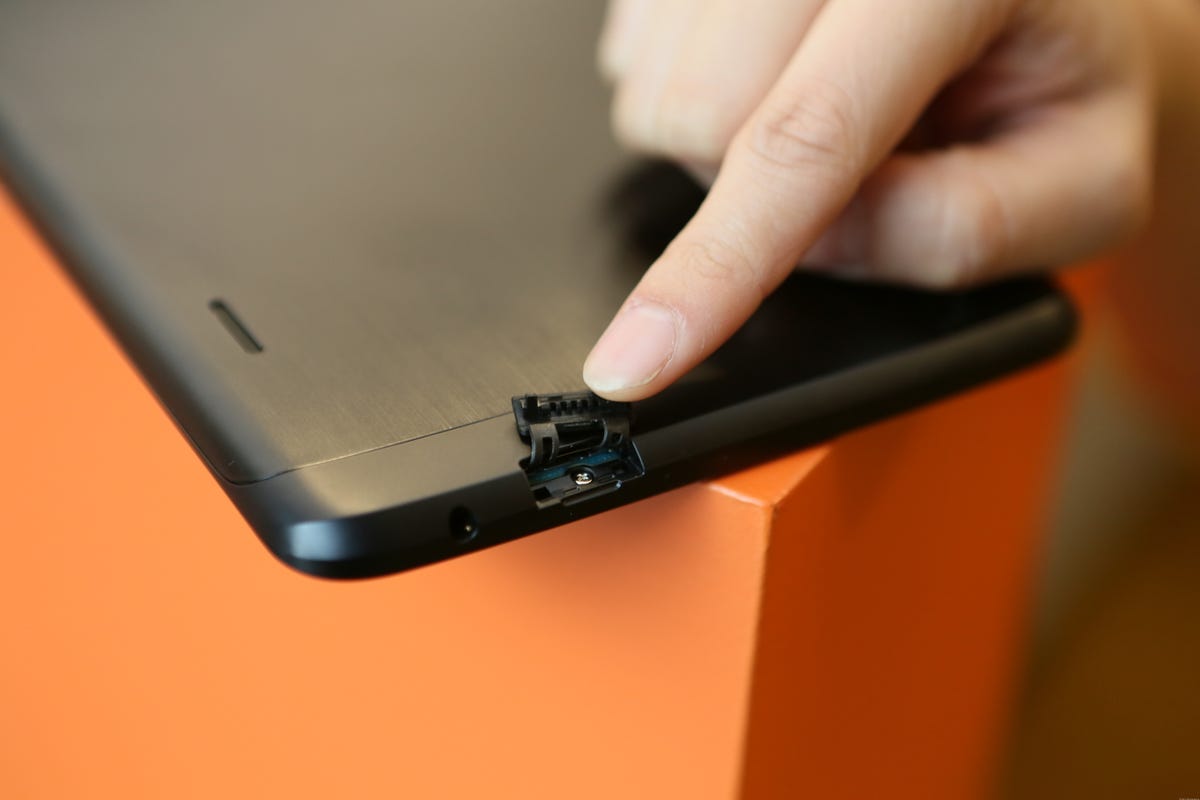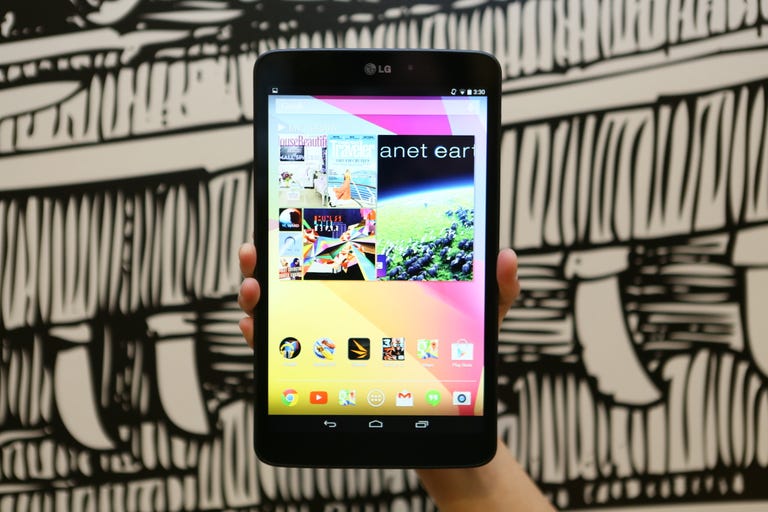 Why You Can Trust CNET
Why You Can Trust CNET LG G Pad 8.3 Google Play Edition review: Dependable tablet gets pure Android facelift
Already a fast, reliable tablet, Google's LG G Pad 8.3 reboot to pure Android 4.4 only makes it better.
If you're an Android purist, you're going to love this Google Play edition of the LG G Pad 8.3. Nearly identical to the original in hardware, the major difference you'll find between the two versions comes down to the operating system and skin that you interact with.
The Good
The Bad
The Bottom Line
While LG's first version runs the company's Optimus 3.0 user interface, this G Pad runs the unadorned stock version of Android 4.4 KitKat. You do lose a lot of LG's built-in software features in the transition, which is a shame for the more useful features among them. However, the pure Android G Pad has other benefits. The device itself is already as reliable, and at times faster, than LG's original, but it will also receive OS updates as they roll in.
Available online at Google's Play Store for $349, Google's model costs just as much as the original when it first launched (though now, the latter costs $50 less at Best Buy). Though it's price isn't exactly inexpensive, it's reasonable -- especially for those dead set on a mid-sized tablet with vanilla Android.
Editors' note: Due to the similarities of the tablets, portions of this review have been lifted from the original LG G Pad 8.3 review.
Design
The device measures 8.54 inches tall, 4.98 inches wide, and 0.33 inches thick. Positioned vertically, it's easy to hold with one hand, which surprised me given how small my grip is. It also weighs 0.74 pound (or 11.8 ounces), so its relatively lightweight. You can easily throw it in a small shoulder bag and it wouldn't feel like a huge drag on your shoulders. In addition, with its 8.3-inch touch screen, it's the ideal solution for those who think the Nexus 7 is too small and the 10 is too large.
Though it makes the G Pad a bit more slippery, I like the device's smooth, faux-metal back panel. In fact, I prefer it over the Samsung Galaxy Tab 3's glossy backside, which traps fingerprints easily. I also like how the tablet feels dense, without being too heavy. Both characteristics give the G Pad a polished look.
| LG G Pad 8.3 | Google Nexus 7 (2013) | Samsung Galaxy Tab 3 (8-inch) | Apple iPad Mini | |
|---|---|---|---|---|
| Weight in pounds | 0.74 | 0.66 | 0.7 | 0.68 |
| Width in inches (landscape) | 8.5 | 7.8 | 8.2 | 7.9 |
| Height in inches | 5 | 4.5 | 4.8 | 5.3 |
| Depth in inches | 0.33 | 0.34 | 0.27 | 0.28 |
| Side bezel width in inches (landscape) | 0.63 | 1 | 0.75 | 0.81 |
But while its build quality is solid, the device's plastic trimmings dampen its overall aesthetic, and compared to other small tablets, the G Pad just doesn't look as chic.
For example, although CNET's Eric Franklin prefers the stylings of the 2012 Nexus 7 over the 2013 edition, the most recent Nexus is still much sleeker than the G Pad, with its starkly sharp corners and black all-matte construction. And even though I don't like the Tab 3's backside, its steep, metallic-trim edges look elegant. Lastly, the Apple iPad Mini's alluminum body and trimming definitely give the Mini a more high-end, refined aspect.

On the device's top edge you'll find a 3.5mm headphone jack, and a microSD card slot that's expandable up to 64GB. The right houses a sleep/power button and volume rocker. At the bottom is a Micro-USB port for charging and transferring files.
Above the display is a 1.3-megapixel front-facing camera. On the back is 5-megapixel camera, which sits to the left of two narrow slits for the audio speaker.
Software features
Because it is branded by Google this time around, the G Pad won't feature any of LG's built-in software features seen in the first model. That eliminates some superfluous functions I never saw myself using regularly (like QuickMemo and Slide Aside), but it also means getting rid of others that I found to be pretty useful, such as QPair and QuickRemot, with the latter app working in conjunction with the tablet's IR blaster to turn your device into a TV. (For more info on these features, check out the original review.)
But being a Play Edition model does have its benefits. For one thing, instead of running Android 4.2.2 Jelly Bean out of the box like LG's version, this one has 4.4 KitKat. In addition, after I started up the G Pad, it immediately prompted me to download and install 4.4.2, which just launched a few weeks ago.
I also find the user interface more refreshingly simple and elegant, you'll get a smidgen more available internal space, and you won't have to worry about getting inundated by third-party software apps.
In fact, along with all the basic task-managing apps (like the calculator and alarm clock), all the other Google apps take up just one page of the drawer. This includes Chrome, Currents, Drive, Gmail, Plus, Hangouts and Keep. There's also Maps, Photos, apps for all the Play Store portals, Quick Office, Wallet, and YouTube.
Lastly, there's the a deeply integrated version of Google Now. You can launch this feature either by saying "Okay Google," or by swiping from the bottom of the home screen.
Hardware features
Inside the tablet is a quad-core 1.7GHz Snapdragon 600 processor, a Qualcomm Adreno 320 GPU, 2GB of RAM, and 16GB of internal storage. It also supports 802.11 a/b/g/n (2.4 and 5GHz) Wi-Fi and Bluetooth 4.0 LE. You'll also get a gyroscope and an accelerometer. To see how these innards compare to others, check out the chart below.
| Device | CPU | GPU | RAM | OS tested |
|---|---|---|---|---|
| LG G Pad 8.3 Google Play Edition | 1.7GHz Snapdragon 600 processor | Adreno 320 (single-core) | 2GB | Android 4.4.2 |
| LG G Pad 8.3 | 1.7GHz Snapdragon 600 processor | Adreno 320 (single-core) | 2GB | Android 4.2.2 |
| Google Nexus 7 (2013) | 1.5GHz quad-core Qualcomm Snapdragon S4 Pro | Adreno 320 (single-core) | 2GB | Android 4.3 |
| Samsung Galaxy Tab 3 (8-inch) | 1.5GHz quad-core Exynos 4 Dual (4212) | Mali T400MP4 (quad-core) | 1.5GB | Android 4.2.2 |
| Apple iPad Mini | 1GHz dual-core Apple A5 | PowerVR SGX543MP2 (dual-core) | 512MB | iOS 6.1.3 |
Performance
The Corning glass HD IPS touchscreen has a 1,920x1,200-pixel resolution and 273ppi. The display is not only responsive and sensitive to the touch, but also crisp and sharp. I think it's a great size for watching movies and playing games. After using it for a while, the "smallness" of the Nexus' 7-inch screen is strikingly apparent.
Though previous observation showed that the G Pad's screen looks dimmer compared to its competitors (especially when viewing a white swatch), the display, in general, is great. It's sharp, and it has a wide viewing angle. It's also easy to view outdoors in sunlight, and text and menu icons look smooth. For information about the tablet's display and its brightness and contrast ratio, head over to the initial LG review.
Though Google's G Pad has identical hardware as its LG original counterpart, I noticed slight, but still marked improvements with the former's internal speeds. True, the latter performed quickly and reliably enough already, but it was clear that basic things like opening the app drawer, launching Chrome, and returning to the homepage, took just a hair longer when compared to Google's device.
The pure Android tablet also executed more complicated tasks consistently faster as well. Loading the first level of N.O.V.A 3, for example, took 32 seconds, which is 2 seconds shorter than the original G Pad and on par with the Nexus 7. And while neither devices outperformed the Nexus for our 3DMark tests (save for the Physics Test portion), Google's model always scored better than the LG version. In addition, it beat out the Samsung Galaxy Tab 3 and the Apple iPad Mini as well. (For more on the 3DMark test, click here.)
(Shorter bars indicate better performance)
(Longer bars indicate better performance)
(Longer bars indicate better performance)
(Longer bars indicate better performance)
Similar to the majority of tablets on the market, the device's cameras were decent, but not overly impressive. Objects that were taken up close or in slightly dim lighting came out grainy with a notable amount of digital noise. Colors also looked muted and edges often were blurred or out of focus.
Since it doesn't have LG's built-in camera and photo editing software, you won't get features like pausing while recording, activating the shutter with a voice command, or selecting live effects that comically distort your face. However, you will get HDR shooting, four scene options, panoramic shooting, and Photo Sphere (which has been available since Android 4.2). It stitches together pictures taken from every angle at a single point, and creates engrossing 3D-esque photos.
Anecdotally, the device's 4,600mAh battery lasted well enough. It can definitely survive the workday with medium usage and screen brightness cranked all the way up. Though I will update this review when CNET lab test results come in, LG's previous G Pad lasted 6.4 hours of testing. More tablet testing results can be found here.
Conclusion
When the LG G Pad 8.3 initially launched, I said it was expensive compared to its rivals, which at the time included the iPad Mini, the Samsung Galaxy Tab 3, and the Google Nexus 7. The 7 had the most glaring price difference: if you choose the equivalent 16GB, Wi-Fi only model, it was $121 less than the G Pad, and had all the software benefits of a Google-branded device.
With the Play Edition of the G Pad, however, things get a bit more nuanced. Since it's sized between the 7 and 10 tablets, its price falls somewhere in the middle too. Though $350 is still a decent amount of money to fork over, Android fans will enjoy the extra inches of screen real-estate, software updates, and simplified UI. Plus, the faster performance speeds should be welcomed by all, no matter how much you like the vanilla OS.
However, with the launch of Google's G Pad, comes a lower $299 price with LG's original model. That's $50 back in your pocket for essentially the same tablet -- a tablet that was fast and reliable to begin with.
If you're looking to save dough and don't mind a smaller screen, the Nexus 7 is still the reigning king of small-sized tablets. But if you want something a bigger, can live without pure Android, and don't need updates the moment they're available, go for LG's original G Pad version. If you're set on the stock Android version of the OS, however, and the Nexus 7 just isn't big enough, then Google's edition of the G Pad will be worth the extra $50.


